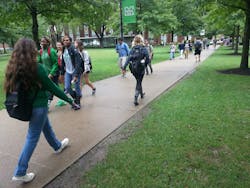Designing for Safety in Higher Education Facilities
Architects and designers focus on the structural design, floorplan layout and aesthetic of buildings to best meet the needs of the users. But when it comes to the design of educational facilities, are you accounting for the safety of the design early enough in the process?
Exterior Campus Safety Strategies
Campus safety should not be an afterthought, argued Alex Halliday, Genetec’s Regional Director for the consultant group of Canada. Utilization of security consultants early in the design and building processes can ensure safety remains at the forefront of design and can even reduce the security budget later, Halliday says.
“If security and operational security are involved in the conversation, then you can take advantage of the resources in different ways to incorporate into the architectural design to reduce the security budget,” he said. “Instead of having security pay for a fence, you’ve got landscaping paying for a hedge and making everything look proper and work together.”
Colleges and universities should be designed with clear lines of sight and controlled access points, which does not stop at the design of buildings.
Paul Timm, director of education safety for Allegion who has assessed over 2,000 schools, said Crime Prevention Through Environmental Design’s (CPTED) principles were designed to reduce crime, which can be accomplished through intentionally well-designed, maintained, and friendly natural environments that foster a culture of safety.
“It all comes from what was called the Broken Windows Theory–if you have a building and you come in on Monday and you find out a window was broken and you put in a ticket and replace it a week from now, you’re going to have more broken windows,” Timm said. “But if you replace it immediately and return it to situation normal, you’re far less likely to get more broken windows.”
Updates to lighting, controlled access points and increased security can enhance campus security. LED lights are most popular because of their efficiency and brightness but may require community sessions to address concerns.
“Occasionally we’ll get people who say, ‘My neighbors are complaining about lighting, so I can’t run that lighting,’” Timm said. “It’s safest for the community to run that lighting at night because the band concert gets out late and we don’t want kids walking through a dark parking lot–we don’t want anyone walking through a dark parking lot and police want to clearly see as they drive by.”
Cones can be placed on exterior lights to direct illumination down, reducing impacts to neighbors, if necessary. However, higher-education campuses can educate the community about how lights enhance safety not only on campus but also on the adjacent properties. Layered lighting is a technique used to ensure the type of light is conducive to the needs of the space. Halliday said certain light is better for the eye, but not good for video surveillance, so an evaluation for interior and exterior spaces will inform which lighting type to use.
The presence of good lighting and vegetation is crucial in parking lots, along walkways and at entries. Timm noted CPTED guidance states no shrubs should be taller than three feet and all tree limbs should be cleared 8 feet high in those areas. Timm recommends architects involved in landscape design around those three areas should plant something with the word miniature in the name to maintain that line of sight. Recent landscape trends are incorporating decorative grasses like prairie grasses or tiger grasses. While the natural aesthetics are pleasing, the grasses are tall and obstruct views.
The outdoor campus environment also needs security measures in place to keep everyone safe during their time on campus. Open spaces for soccer fields, concerts or even pathways around campus can benefit from shrubbery and hedges that maintain visibility, but funnel access. Planting waist-high hedges and trees with no low-hanging branches as well as placing planters in front of buildings that have reinforced steel in the center can make a campus aesthetically pleasing while incorporating natural security features.
In areas with fall hazards, use anti-slip tape and signage to alert people of those risks. Install video cameras to capture traffic for the institution’s protection against legal action. It’s also important to consider properties and businesses adjacent to the campus property and how people enter and leave those spaces. That can inform the layouts of campus buildings. Future campus growth should also be discussed as part of campus safety strategies to ensure the current project’s infrastructure flows into future expansion and renovation plans.
Tips to Secure Classrooms
Classrooms should also have a good line of sight, so faculty and students can see the entire room, and if someone threatening enters, people have time to react.
Effective security implementation requires communication between the builders and campus leadership to identify the risk and security tolerances.
“You can have a secure campus that has every door locked, no windows, walls and gates that essentially look like a correctional institution, but that’s not a very good learning environment,” Halliday said. “On the other end of the spectrum, you have this open field and easy buildings and tents with no security. So, how do the architects have good communication with the end user to understand what their security and risk tolerances are to make it balance?”
With tolerances identified, architects can also develop evacuation routes and shelter-in-place locations to meet each campus’ needs. Primary and secondary evacuation routes should be marked within classrooms and hallways, along with appropriate exit signage. A higher-education campus in Florida may need shelter in place for a weather-related concern not found on campuses in landlocked areas. Other instances may be for a security incident, so campuses need to be able to secure doors and windows.
Strategies that campuses, especially open campuses, can implement to deter and prevent unauthorized access to buildings include visible security personnel and security points, intercom systems, and video surveillance to control access remotely. Designs for higher-education student residential halls that feature secured vestibules and limit access by floor add layers of security to those buildings. Timm said laminated or ballistic glass will be the new standard for exterior doors. The glass is transparent but prevents someone from breaking it as they can tempered glass. That shift comes after the March 2023 Covenant School shooting in Nashville, where a shooter fired through panes of glass on the exterior doors.
Building locations and pathways should be placed with safety in mind. Timm noted how the COVID-19 pandemic called to light the importance of controlled access and wayfinding.
“Wayfinding is a silver lining of the pandemic because in the pandemic we had to be very careful with where people were coming in and then we couldn’t let them all cluster in one place,” Timm said. “We had to egress through a different door and wayfinding helped us with all of this.”
Architects and designers may prioritize structural design and aesthetics when planning educational facilities. But safety is just as important, if not more when constructing campus buildings. You can integrate safety measures into your designs for higher education to ensure the resiliency of the building, save money and save lives.
Enhancing Campus Emotional Safety
Strategies for a secure and welcoming environment.
Emotional safety is established when campuses create and maintain a secure environment, said Sean Ahrens, security market group leader for Affiliated Engineers. He said students who are in fear of crime associated with criminal behavior, homelessness and gang activity on or near campus may not venture out at night. Thus, students and faculty must feel safe and willing to meet at events to foster community, which will not happen when people are in fear.
“By introducing these security elements, we have a better opportunity to introduce witness potential at all times,” Ahrens said. “If we can create a safer environment and we can maintain it, I submit you will see enhancements in student registration and attendance over a period of five to seven years.”
Common spaces designed for activities and groups help attract students to areas, increasing witness potential. “We want people to stay, remain and travel through areas, which indirectly bolsters community,” he said. Witness potential is a deterrent for potential perpetrators because bystanders and passersby can observe activity, which creates apprehension in an aggressor considering criminal acts. Ahrens said that activity support can foster security through the introduction of communal spaces like kitchens, lounges and game areas to draw students/invitees to an area, that otherwise would be isolated and without witness potential; this is especially important for living areas.
Designs with natural access controls like shrubbery or fences direct traffic in and out of an area. Maintenance and upkeep of buildings and campus safety features also support subconscious emotional safety. Signage that reads “Video Surveillance and 24/7 Monitoring” has limited benefits and can increase liability. Campuses should increase the potential for upkeep and ownership by identifying areas prone to vandalism, like call boxes, which are likely targets for these acts. Areas prone to vandalism, “tagging” and other acts can be equipped with a sacrificial coating to allow the
removal of graffiti or stickers. Upkeep enhances the perception of ownership and the equivalent of a secure environment. Attractive nuisances are items or amenities, which can draw illegitimate users to an area. These nuisances should be recognized and controlled. Exterior access to potable water from drinking fountains or electrical outlets can exacerbate vagrancy on campuses. Ahrens recommends turning off outdoor fountains during hours of darkness and equipping fast drains. He also recommends eliminating or controlling electrical outlets and minimizing areas where sitting/lying can occur–within an alcove or near a ventilation/exhaust shaft at grade.
Knowledge of campus threats can help inform how to construct buildings to protect people and intellectual property. Compartmentalization of inner hallways and classrooms is possible, and fluid spaces can be controlled with the push of a button. Hidden features enhance safety and dramatically delay an assailant from reaching staff and students while being completely unobtrusive. Ahrens also recommends applying the same compartmentalization philosophy for the exterior of buildings, anticipating direction and controlling vehicle and pedestrian traffic through expected routes.
“I would much rather have classrooms that are like T’s,” he said. “In most schools, you go down the hallway and the classroom doors are right off the hallway. As an aggressor, at the door, I’m going to see about 65% of that classroom from that doorway.”
Inset corridors for the classroom doors limit the aggressor’s view and additional shatter-resistant film with deadbolts make for a formidable defense.
Biophilic design in educational facilities fosters a connection with the natural world, enhancing the well-being of staff and students. Large windows should have balanced glazing and lighting to minimize mirroring effects and increase witness potential.
Builders and designers can proactively employ these strategies to prioritize security, which can impact the emotional safety of faculty and students as well as foster a strong sense of community that adds to the university experience, leading to its byproduct of a return on investment through increased registration over a finite period of time.
About the Author
Lauren Brant
Buildings Editor
Lauren Brant is the editor of Buildings. She is an award-winning editor and reporter whose work appeared in daily and weekly newspapers. In 2020, the weekly newspaper won the Rhoades Family Weekly Print Sweepstakes — the division winner across the state's weekly newspapers. Lauren was also awarded the top feature photo across Class A papers. She holds a B.A. in journalism and media communications from Colorado State University - Fort Collins and a M.S. in organizational management from Chadron State College.

